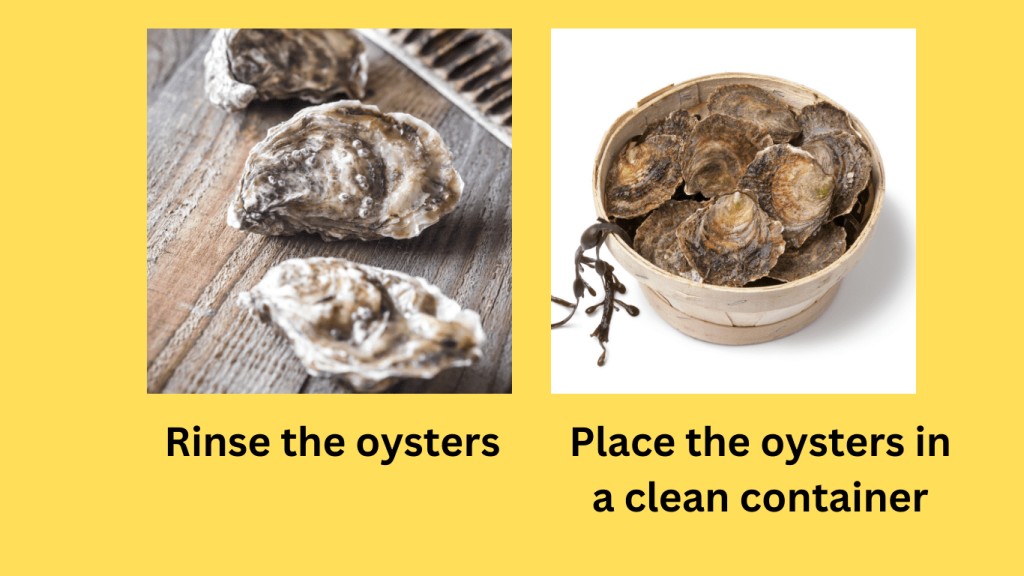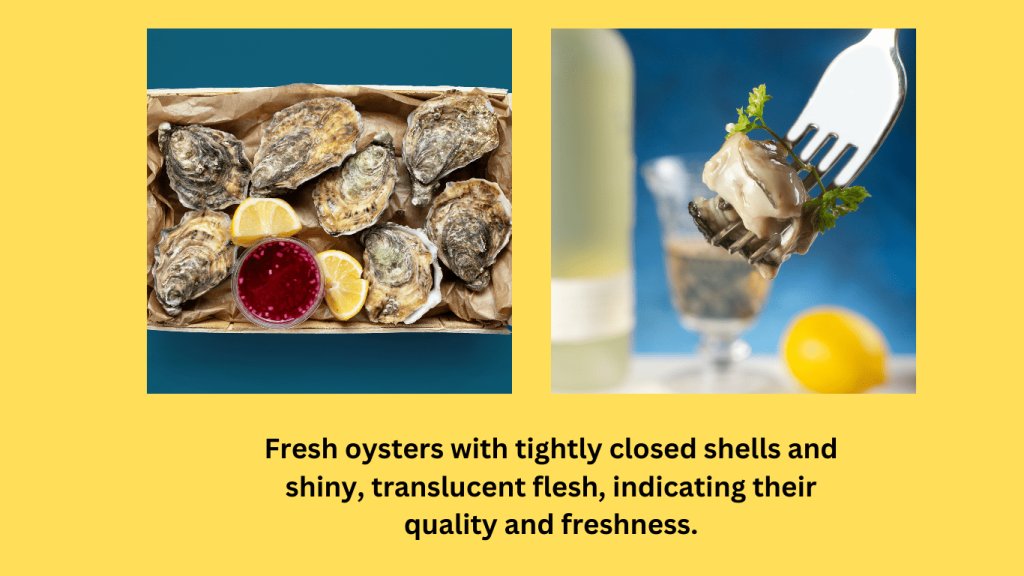
Fresh oysters provide a delicious and nutritious seafood delicacy that you can enjoy in a variety of ways. Such as incorporating them into stews, soups, and pasta dishes. However, it is essential to store them correctly to maintain their freshness, flavor, and safety. In this article, we will provide you with tips and guidelines on how to store fresh oysters properly.
Factors That Affect the Shelf Life of Fresh Oysters

It is crucial to understand the factors that affect their shelf life to maintain their freshness, flavor, and safety.
Factor 1: Harvesting and Handling
How oysters are harvested and handled can significantly impact their shelf life.
Oysters harvested from clean and unpolluted waters tend to have a longer shelf life compared to those harvested from polluted areas.
Additionally, gentle handling and refrigeration during transportation and storage can also extend their shelf life.
Conversely, exposing oysters to high temperatures, direct sunlight, or rough handling can accelerate their spoilage.
Factor 2: Storage Temperature and Humidity
Temperature and humidity are critical factors that affect the shelf life of fresh oysters.
To prevent bacterial growth and spoilage, store oysters below 40°F (4°C).
Oysters last longer in a humid environment than in a dry one.
Storing oysters in airtight containers or bags increases their shelf life compared to exposing them to air.
Factor 3: Time Since Harvest
The time that has elapsed since the oysters were harvested is also a crucial factor that affects their shelf life.
If stored correctly, freshly harvested oysters can remain fresh for up to two weeks.
Oysters that exceed a two-week storage period are more prone to spoilage and, therefore, have a shorter shelf life.
Before consuming oysters, it’s crucial to check the harvest date and storage conditions to ensure they are safe to eat.
Factor 4: Quality of the Oyster Meat
The quality of the oyster meat is another factor that affects the shelf life of fresh oysters.
High-quality oysters with plump and firm meat have a longer shelf life than poor quality ones.
Oysters that have been damaged, bruised, or infected with bacteria spoil more easily and, therefore, have a shorter shelf life.
Before purchasing or consuming oysters, it’s vital to inspect them carefully.
How to Store Fresh Oysters

In this article, we will provide you with tips and guidelines on how to store fresh oysters properly.
Learn How to Choose Fresh Oysters
When buying oysters, it is important to choose a reputable seafood market or restaurant that specializes in seafood. Look for oysters that are tightly closed or have a slightly open shell that closes when tapped. It is best to avoid oysters that are already open or have a strong odor, as they may be spoiled or dead. Additionally, it is important to check the label or ask the vendor for information on where and when the oysters were harvested to ensure they are safe to eat. Taking these precautions can help you enjoy fresh and high-quality oysters while minimizing the risk of foodborne illness.
How to Store Fresh Oysters for Short-Term
If you plan to consume your fresh oysters within a day or two of purchase, you can store them in the refrigerator. Here’s how:
- Rinse the oysters with cold water to remove any debris or dirt.
- Place the oysters in a shallow dish or tray, with the flat side facing up.
- Cover the oysters with a damp towel or paper towel to keep them moist.
- Place the dish or tray in the refrigerator, and use them within two days.
How to Store Fresh Oysters for Long-Term
If you want to store fresh oysters for more than two days, you can freeze them. Here’s how:
- Rinse the oysters with cold water to remove any debris or dirt.
- Place the oysters in an airtight container or freezer bag, with a small amount of the oyster liquor or water to cover them.
- Label the container or bag with the date and freeze it.
- Use the frozen oysters within three months for the best quality.
Safety Guidelines
To avoid the risk of foodborne illness, it is essential to follow these safety guidelines when storing fresh oysters:
- Always keep the oysters at a temperature below 40°F (4°C) to prevent bacterial growth.
- Discard any oysters that have an off odor, are slimy or soft, or have a broken or cracked shell.
- Never eat raw oysters that are not alive, as they may contain harmful bacteria that can cause illness.
- Always cook oysters thoroughly before consuming them.
How to Tell if Fresh Oysters Has Gone Bad

To minimize the risk of consuming spoiled oysters, it is crucial to know how to identify if they have gone bad. Therefore, I will provide you with a guide on how to detect if fresh oysters are no longer safe for consumption.
Smell
- Fresh oysters have a mild, briny, and oceanic smell.
- Oysters that have gone bad will have a strong, unpleasant, and fishy odor.
- Discard any oysters that emit a sour or ammonia-like odor as they have gone bad and are no longer safe to consume.
Appearance
- Fresh oysters typically have tightly closed shells and a shiny, moist, slightly translucent flesh.
- If oysters have an open or gaping shell, they are likely dead and should be discarded.
- Oysters with a cloudy or milky appearance or black spots on the flesh are not fresh and should be avoided.
Texture
- Fresh oysters should have a firm, plump, and slightly chewy texture.
- Discard oysters if they feel soft, slimy, or mushy. They are likely dead.
- Oysters that are tough or rubbery are overcooked and not fresh.
Taste
- Fresh oysters should have a mild, sweet, and briny taste.
- Discard oysters if they taste sour, metallic, or like ammonia.
- Avoid oysters that have a cloudy or milky appearance or black spots on the flesh, as they are not fresh and may not be safe to eat.
Conclusion
Now that you know how to store fresh oysters properly, you can enjoy this delicious seafood anytime you want. Remember to choose high-quality oysters, use the right storage method, and follow safety guidelines to ensure the best taste and health benefits.
FAQ About How to Store Fresh Oysters
It is not recommended to store oysters with other types of seafood in the same container or refrigerator. Oysters can easily absorb odors and flavors from other foods, which can affect their taste and quality. Additionally, some types of seafood may carry harmful bacteria or viruses that can contaminate the oysters and cause foodborne illness. It is best to store oysters separately in their own container or bag in the refrigerator.
The ideal temperature for storing fresh oysters is below 40°F (4°C). Oysters are sensitive to temperature, and storing them at higher temperatures can increase the risk of spoilage and bacterial growth.
It is not recommended to store fresh oysters in water for an extended period. Oysters require oxygen to survive, and submerging them in water can cause them to suffocate and die. Additionally, storing oysters in water can increase the risk of bacterial growth, which can lead to spoilage and foodborne illness.
It is recommended to store fresh oysters unshucked. This helps to maintain their freshness and flavor for a longer period. Once shucked, oysters should be consumed as soon as possible.
Avoid washing oysters before storing to prevent excess moisture that increases the risk of spoilage. Store oysters in a cool, dry place, such as a refrigerator on ice, until ready to shuck and consume. If you need to clean oysters before storage, it is best to rinse them briefly in cold water and then dry them thoroughly before refrigerating them.


